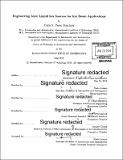Engineering ionic liquid ion sources for ion beam applications
Author(s)
Perez Martinez, Carla S. (Carla Sofia)
DownloadFull printable version (32.24Mb)
Other Contributors
Massachusetts Institute of Technology. Department of Aeronautics and Astronautics.
Advisor
Paulo Lozano.
Terms of use
Metadata
Show full item recordAbstract
Ionic liquid ion sources (ILIS) are devices capable of producing positive and negative molecular ion beams through field evaporation from room-temperature molten salts. If sufficiently high hydraulic impedance from the liquid-supporting emitter is provided such that the ratio of flow rate Q to liquid's electrical conductivity K is sufficiently small, a pure ionic regime (PIR) can be achieved, in contrast with traditional electrosprays that produce charged droplets, or mixtures of droplets and ions. The PIR provides high current density from a point source, making ionic liquid ion beams suitable for use in focused ion beam (FIB) applications. The use of ionic liquids in focused ion beams could allow the production of sub-100 nm beams of up to kiloDalton organic ions as well as reactive species, with the possibility of engineering ionic liquid properties for a specific application. In addition, using micro-fabricated and nano-structured emitter arrays operating in the PIR can give access to efficient and compact positive or negative ion sources, for applications from spacecraft thrusters to deep reactive ion etchers (DRIE). There is a need for novel tip geometries and materials that favor the stable formation of a single emission site on the liquid supporting structure, while providing a continuous liquid supply compatible with the PIR. In this thesis, porous carbon based on resorcinol-formaldehyde xerogels is introduced as an emitter substrate. The target pore sizes and emitter geometries to attain the PIR are obtained through analytical estimates. The carbon xerogel can be shaped to the required micron-sized geometry through mechanical polishing. Time-of-flight mass (TOF) spectrometry is used to verify that charged particle beams produced from the mechanically polished carbon xerogel source, infused with the ionic liquid 1-ethyl-3-methylimidazolium tetrafluoroborate (EMI-BF₄), contain solvated ions exclusively. In the case of the liquid 1-ethyl-3-methylimidazolium bis(trifluorometrylsulfonyl)imide (EMI-Im), mixed ion-drop operation is obtained. Laser micro-machining has been validated as a manufacturing technique to shape carbon xerogel into emitters. This technique should allow the production of emitter arrays for DRIE or propulsion applications, and allow the reproducible fabrication of emitters for FIB. Stable emission has been obtained from a laser micromachined tip infused with the ionic liquid EMI-BF₄ . The results of TOF and retarding potential analysis (RPA) experiments indicate that the emission consists mostly of monomers and dimers, and that a small fraction (< 5%) of the beam might be composed of cluster ions with greater degrees of solvation. To conclude, the thesis reports on the etching properties of the beams obtained from ILIS, both in the case of traditional externally wetted tungsten sources and with the novel carbon xerogel emitter technology. The W ILIS etches silicon with sputtering rates between 6 and 35 atoms of silicon removed per incident ion at 15 keV irradiation energies, whereas the carbon xerogel ILIS has been used to etch gold, silicon and gallium nitride with sputtering rates in the order of 10 for irradiation energies between 2 and 7 keV.
Description
Thesis: Ph. D., Massachusetts Institute of Technology, Department of Aeronautics and Astronautics, 2016. Cataloged from PDF version of thesis. Includes bibliographical references (pages 177-186).
Date issued
2016Department
Massachusetts Institute of Technology. Department of Aeronautics and AstronauticsPublisher
Massachusetts Institute of Technology
Keywords
Aeronautics and Astronautics.